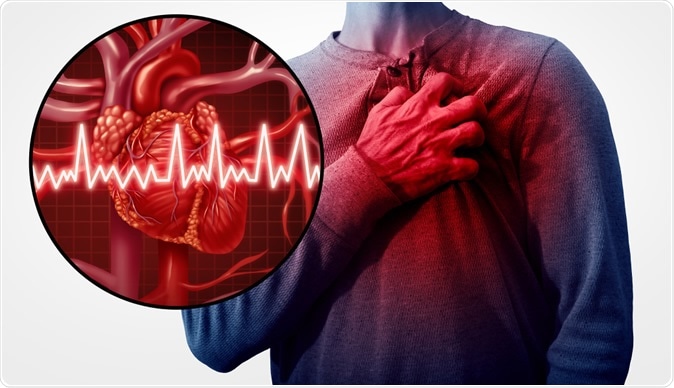Researchers have developed a new and easier method of detecting irregular heart rhythms such as Atrial Fibrillation (AF or AFib) after a stroke. At present clinical rely upon standard cardiac telemetry to detect AF seen commonly after a stroke.

Image Credit: Lightspring
The team of researchers from Michigan Medicine have now developed the electrocardiomatrix that would be able to look at large amounts of cardio telemetry data to find and detect AF if present.
The results of the research with the new technology were published in a study titled, “Electrocardiomatrix Facilitates Accurate Detection of Atrial Fibrillation in Stroke Patients” in the latest issue of the journal Stroke.
According to the co-inventor of the electrocardiomatrix technology, Jimo Borjigin, an associate professor of neurology and molecular and integrative physiology at Michigan Medicine, “We validated the use of our technology in a clinical setting, finding the electrocardiomatrix was an accurate method to determine whether a stroke survivor had an Afib.” The team used data from 260 patients of stroke to prove that their technology was effectivie in determining AFib.
The researchers explained that an episode of stroke is followed by a keep look at all the risk factors that could lead to another similar stroke in the future. Detecting AF or AFib is one such risk factors that the physicians must look for. First author of the study Devin Brown, M.D., professor of neurology and a stroke neurologist at Michigan Medicine, explained that looking for AF is one such measure to search out a risk factor for another stroke. She said, “Atrial fibrillation is a very important and modifiable risk factor for stroke.”
According to Borjigin, they detected AF in 212 patients in their study accurately. These patients did not have previous history or records of AF she confirmed. She explained that patients who have never had AF in the past are the ones to look out for after an episode of stroke. She added that the irregular heart beat from the AF in such patients could lead to formation of clots that could lead to another clot formation. Taking a blood thinner or an anti-coagulant may prevent such incidences she said.
Patient data was gathered from a stroke unit between April 2017 and January 2018. The electrocardiomatrix generated the results from the data from the patients’ telemetry that was analyzed by a nonphysician researcher. The team then compared medical record documentation of AF by the clinicians from the telemetry and the results from the elctrocardiomatrix to check for accuracy of both methods. A total of 265 stroke patients were included of whom 88 percent had ischemic stroke. Results revealed that electrocardiomatrix could be successfully used to detect AF in 260 of the cases.
Brown added that there was a difficulty in detecting AF in patients who had been hospitalized after a stroke. She added, “More accurate identification of Afib should translate into more strokes prevented.” The researchers explain that all patients admitted to the hospital after a stroke are put on a constant cardiac monitor. The idea was to detect an episode or intermittent AF in these patients which could have been missed in the initial electrocardiogram, or ECG.
According to Brown, single snap shots of heart rhythm pictures are difficult to pin point the AF and also for a physician it is difficult to look at all the data generated from the cardiac monitors during the hospitalization of the patient. The neurologists look at the ECGs and could either miss important arrhythmias (false negatives) or detect them when they are not there (false positives).
Borjigin says that their technology of the electrocardiomatrix helps solve this problem of too much data by converting the two-dimensional signals from the ECG into a three-dimensional heatmaps that can allow a clinical to get the whole picture at a glance. She added that this method allows for fast, accurate and correct detection of cardiac arrhythmias and reduces the risk of diagnosing arrhythmias when they are absent – false positives. It also prevents false negatives – declaring no arrhythmias despite the presence of intermittent arrythmias, she explained. She said, “We originally noted five false positives and five false negatives in the study...but expert review actually found the electrocardiomatrix was correct instead of the clinical documentation we were comparing it to.”
Researchers concluded, “The application of electrocardiomatrix to stroke unit-acquired telemetry data is feasible and appears to have superior accuracy compared with traditional monitor analysis by noncardiologists.”
The team hopes that their technology would soon allow physicians to detect arrhythmias in other critical care situations as well. It could help differentiate between arrhythmias like AF and atrial flutter, they add or prevent arrhythmia related complications in patients. Borjigin hopes that this technology could soon be used along with ECG to help patients with arrhythmias. She said, “I believe that sooner or later, electrocardiomatrix will be used in clinical practice to benefit patients.”
Journal reference:
A Devin L. Brown, A Gang Xu, A Alexandra Mary Belinky Krzyske, A Nicholas C. Buhay, A Madeline Blaha, A Michael M. Wang, A Peter Farrehi, A Jimo Borjigin, T Electrocardiomatrix Facilitates Accurate Detection of Atrial Fibrillation in Stroke Patients, D 2019, J Stroke, P 1676-1681, doi:10.1161/STROKEAHA.119.025361, https://www.ahajournals.org/doi/abs/10.1161/STROKEAHA.119.025361